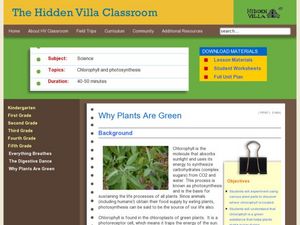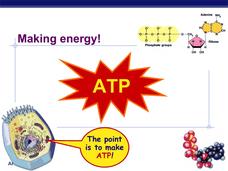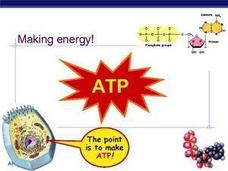Curated OER
Food For the Tuckerbox
In this Australian lunch box packing instructional activity, students study healthy foods suitable to be in a "tuckerbox." Students do their own research about foods popular in Australia, and answer 10 questions. Online answers are...
Curated OER
Food: Discussion questions
In this discussion about food worksheet, students participate in an ask and answer session about food.
Peace Corps
Cuisine and Etiquette
Students identify the main food in the different cultures they have examined. In groups, they compare and contrast their expected table manners to the ones in Sierra Leone, Uganda and Zambia. Using this list of behaviors, they identify...
Curated OER
Micronutrient Need Intervention
Students investigate the real world applications of nutrition. They study the problem of starvation and how it affects different populations. Students work in small groups in order to devise and intervention plan. They also search out...
Curated OER
Why Plants Are Green
Young scholars discover the properties of chlorophyll in plants. In this plant biology lesson, students conduct an experiment to find where the chlorophyll in the plant is located. Young scholars are split into small groups and study...
Curated OER
Vitamin C and Protein Analysis
Students analyze various beverages to determine vitamin C content. Students research diseases resulting from vitamin C deficiencies and identify countries most affected.
Curated OER
Basic Vitamins: Water-Soluble and Fat-Soluble
An incredibly thorough lesson on vitamins, and how to keep one's body at peak health. Learners access a variety of excellent worksheets embedded in the plan that have them consider raw vs. cooked foods, a vegetable nutrition summary,...
Curated OER
World Hunger - Causes And Solutions
An online Sim City type game from the BBC website guides students to complete a World Food Programme mission. They investigate the causes and of hunger in different parts of the world and then research a particular region's hunger...
Curated OER
Race To Win Project
Students develop proper work and personal skills that will enable them to become competent and confident adults. Students analyze basic nutritional habits. Students evaluate sport/athletic food patterns.
Curated OER
Identify Nutrient Sources
Students identify the nutrients in food and its functions. In this nutritional needs lesson, students create a chart that identifies the food source, the function of the nutrient, and the effects of a deficiency or excess of the nutrient.
Curated OER
Mission Meals
Students engage in a investigation of the types of meals that astronauts eat in space while examining the types of nutritional elements needed for optimum physical tasks in space. They are given different foods and then document the...
Curated OER
AP: Chapter 41: Animal Nutrition
Ms. Foglia has created another comprehensive biology worksheet that you can use with your advanced learners. The topic is animal nutrition and the digestive system. Questions address nutrients and deficiencies, stages of food processing,...
Curated OER
Dinnertime for Animals
Is a deer an herbivore? What about a spider? Experiment with the food chain in an interactive science experiment. After listing the herbivores from a selection of animals, third and fourth graders compare the skulls and teeth of...
Curated OER
Lipids: Fats and Oils
A fantastic presentation with great images should improve student understanding of lipids and their involvement in the body. The chemistry of different fats, phospholipids, and steroids are explained. Additionally, the specific...
Curated OER
Making Energy: ATP
The main concepts behind how ATP transfers energy are explained in this Ap Biology PowerPoint. The diagrams convey the information that students need for any test regarding phosphorylation. The steps are clear, and should help...
Curated OER
The Point is to Make ATP
Storing and transferring energy is explained here with reference to the fight or flight response, along with the need for activity in times of lowered nutrition. This is a great summary of ATP applications, and after the multiple stages...
Curated OER
Regulating the Internal Environment
This presentation begins with the many problems multicellular organisms which rely on diffusion encounter. There are many diagrams of mammalian organ structures, and they are labelled with their relevant functions. This an excellent...
Curated OER
Lipids: Fats and Oils
A fantastic presentation with great images should improve student understanding of lipids and their involvement in the body. The chemistry of different fats, phospholipids, and steroids are explained. Additionally, the specific...
Curated OER
Food Pyramid Lab
Third graders complete a lab to review the Food Guide Pyramid and prepare a food item using all of the food groups.
Curated OER
Vegetable Twister
Students review vegetables and their nutrient values and production. In this vegetable production worksheet, students read information about the nutrients in vegetables and how they are grown. Students participate in a game of Twister to...
Curated OER
"Mush Lab"
Students use the information they learned from reading food labels to create mush meals. They blend unlikely meals together to form the mush and then evaluate its nutritional value. They examine their own eating habits after the lab is...
Curated OER
Belonging and Identity
Students participate in a class in which they eat in different social groups. As a class, they discuss the importance of eating a healthy diet and how some foods are harmful to some but not to others. They use the internet to research...
Curated OER
Fatty Food
Students view various types of food that are listed as bad for all people. Students chart out all findings within this lesson. Students talk in an open forum of ways they could change their eating habits in the future.
Curated OER
Eat A Rainbow!
Students demonstrate the importance of eating fruits and vegetables. In this nutrition activity, students identify and sort different fruits and vegetables by colors. Students list reasons why eating fruits and vegetables are important...























